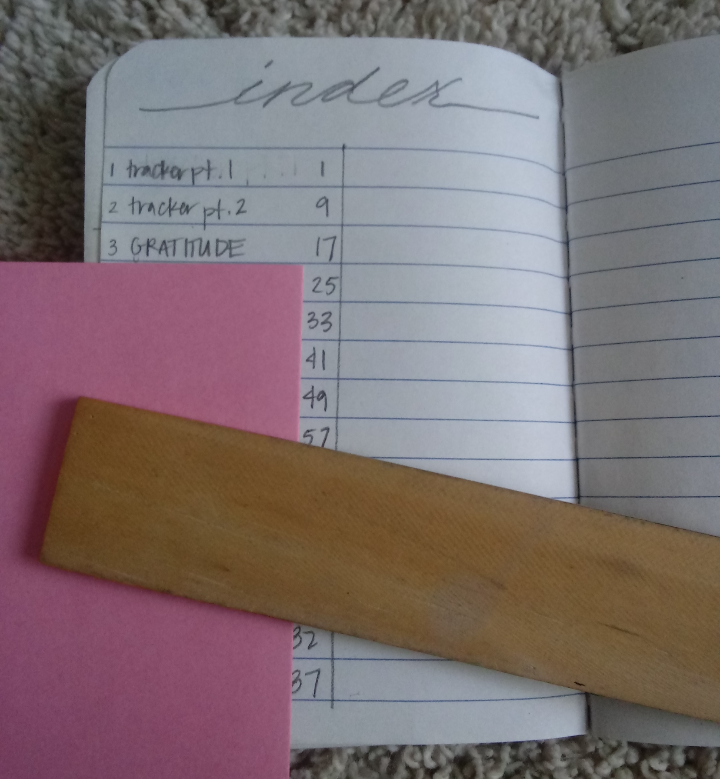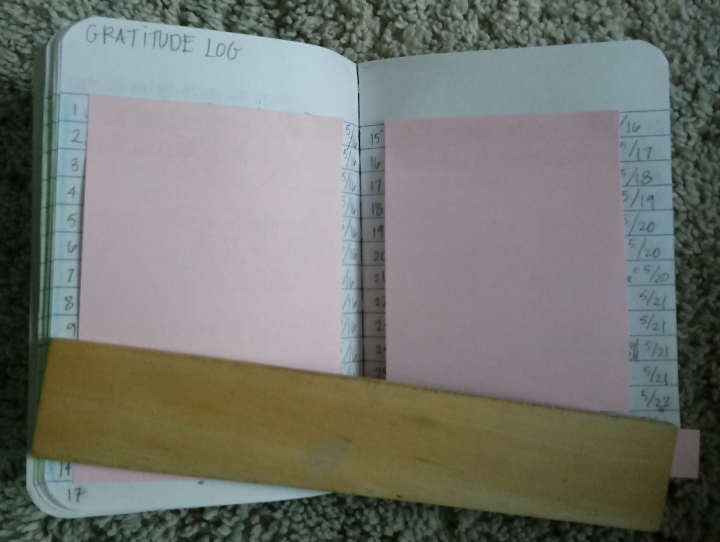 [Edited for Clarity 08/14/2021]
[Edited for Clarity 08/14/2021]
This idea came to me when I started searching for a planner insert to work on changing some challenging habits I had. I kept seeing, and clicking on these Pins for how to change habits, but they’d end up being ads for an app. When doing my personal work, I don’t like using an app. I like keeping my things on paper, where I know the records might not one day up and disappear.
I then thought, “Wait, I can do this in a book.”
So for anyone working on unlearning challenging, and hard to let go of habits//patterns, (and like writing things down) this might work for u 👍
Supplies:
- Little dollar store composition book (4.5”x3.25”)
- A small ruler (so you can carry it around with you)
- A pencil
This book is loosely formatted in the Bullet Journal style. You just keep adding in pages, collections as you think of them, and then just log them in an Index for easy navigation.
Index Page
I’ve covered up my personal page titles in the photo above, but they are like “Gratitude”, “Food Log”, “Illness Log”, “Perception Reminders”, etc. Anything that I am working on that needs to go. I pulled themes from any frequent recurring issues that have been popping up in my daily journal pages.
The Tracker Pages
So on the first page to the left (covered in photo), I numbered the page lines down the left hand side. These are going to be the lines where you enter the areas of your life to be tracked. (I covered up my personal items, but you can see the numbers on the left side of the pink sticky note.)
You can list anything you want here. Anything you currently want to unlearn. And write in whatever way is best for you. Abbreviate when possible so you can fit everything on one line. You’re the only one who’s going to see it, so as long as you know what it says.
Examples of possible tracked items abbreviated:
- “Don’t talk over ppl every1 deserves to b heard”
- “I listen and value ppls opinions”
- “I don’t rush I take my time”
- “When my mind starts spinning I stop + breathe”
Make them as intricate or general as you need.
On the page on the right (the one with all the numbers), draw vertical lines down the page in succession pretty close together to form little boxes. You only need the boxes big enough to be able to fit a 2 digit number. (I just eyeballed it and used a pencil for everything so I could erase mistakes.)
Keeping Track
Whenever you add a new item, put a letter or two in the first box (before you enter a number) to signify the starting month. Then add the date in the next box. (For example the first 6 lines in the photo above start with ‘M’ ’16’ which means I started those on May 16th.)
If you have a significant occurrence during the day with an issue relating to one of your habit, and you successfully (or unsuccessfully) deal with it, go back and note it. Each box is an occurrence. So on the first line in the photo, the date ’16’ shows the first occurrence. The number ‘2’ shows the second occurrence, and so on. The next day’s entry is shown as ’17’, and the process repeats.
Set aside the next 3 pages (back and front = 1 page) or so, so you can continue logging for the next several weeks. Only number the page lines on each additional left page, so you don’t have to rewrite the items. Just match up the numbers and keep logging across the lines.
Along with entering items to track, you can also enter whole collections as a line item. A collection is housed on it’s own page, and can contain lists of anything you may need to read or use as a grouped topic log. (More on Collection Pages below.)
Collection Pages
I blocked off almost all of this (lol), but you can still see the numbering on the left and entry dates on the right. This is my Gratitude Log. Everyday I enter something(s) I am grateful for. The date is recorded on the right.
Everyday I re read the list, and then keep adding on.
This collection page is also entered on one my Tracker pages, so I remember to go read it everyday, and log that I did.
Adding In More
The beauty of the Bullet Journal system is that you can add in things as you go. Nothing has to be in any kind of order, because it’s logged in the Index so you can find it. Additionally, everything is also logged in the Tracker pages.
And when you run out of lines to add more items to your Tracker, you can just start another one.
I also added an additional feature, color coding. I color coded the edges of the pages according to subject of the page. All Tracker pages one color, Food and Health pages another color, Spiritual Stuff another color, and so on. This way when your book is closed, you can look from the side edges and see approximately where to open the book.
Timing
I do my best to go through the Book before I get started doing anything else. This was the ideal, but it got shifted around sometimes. It still worked well for me though.
Note that around the 3 week mark, I started experiencing reluctance to continue. This is usually when I hit my limit when doing healing exercises. I just pushed through it best I could, and even logged my gratefulness for the Book, in my Gratitude Log everyday so I’d get it in my head (lol).
Keep It Loose
This is meant to be loose, and of a more freestyle vibe. It’s even small enough to keep in a zippered jacket pocket for handy transport.
(I also found this link helpful in relation to perspective, “Measure Backward, Not Forward”.)
I hope this is of help for someone who needs it.
All The Best,
Tru
Mini Composition Book, Note Pad, 3 Pack in 3 different color Red, Green & Blue
Pilot G2 Mechanical Pencils, 0.7mm HB Lead, Black/Clear Barrels, 6 Pack





